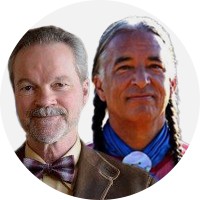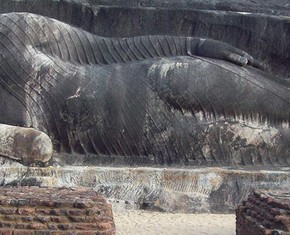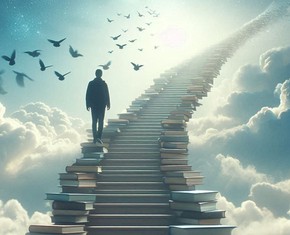The views expressed in our content reflect individual perspectives and do not represent the authoritative views of the Baha'i Faith.
In this continuing series of articles, we’re learning about the Indigenous Messengers of God from the Western Hemisphere—the Prophets who taught native tribal peoples.
The Baha’i teachings say that all peoples have received guidance from the Creator “from time immemorial”:
… the Manifestations of [God’s] Divine glory and the Day Springs of eternal holiness have been sent down from time immemorial, and been commissioned to summon mankind to the one true God. That the names of some of them are forgotten and the records of their lives lost is to be attributed to the disturbances and changes that have overtaken the world. – Baha’u’llah, Gleanings from the Writings of Baha’u’llah, p. 174.
So what impact did those spiritual Messengers have on native peoples? In the previous essay, Kevin Locke said:
When one studies the historical record, one finds that virtually all of early European chroniclers, including Columbus, testified to the moral superiority of the Indigenous people. From whence does that moral compass originate? What is the Source of all goodness? Morality? Spirituality? I believe that we are at the dawning edge of a collective spiritual coming of age when we can acknowledge and celebrate the stupendous heavenly heritage of this side of the planet.
Q: Kevin, this raises a valid point, worth pondering, giving pause for thought. The answers to your rhetorical questions are obvious: the Source of goodly ethical and godly moral teachings must come from God, the Great Spirit, or the Great Being, as Baha’u’llah wrote:
Men at all times and under all conditions stand in need of one to exhort them, guide them and to instruct and teach them. Therefore He hath sent forth His Messengers, His Prophets and chosen ones that they might acquaint the people with the divine purpose underlying the revelation of Books and the raising up of Messengers, and that everyone may become aware of the trust of God which is latent in the reality of every soul. – Baha’u’llah, Tablets of Baha’u’llah, p. 161.
Here, “at all times and under all conditions” sounds quite universal! The specific teachings of any Messenger of God also contain universal precepts and principles. Do you agree?
A: Yes, of course I agree. In fact, I think the following call for recognition of the Indigenous Messengers of God has great importance:
Acknowledgement of the myriad of Messengers of the Creator, the Great Mystery, to the peoples of the Western Hemisphere. – “Declaration of Vision: Toward The Next 500 Years.” Turtle Quarterly (Fall/Winter 1994), p. 8. (Presented at the 1993 Parliament of the World’s Religions in Chicago.)
Q: In this “Indigenous Messengers of God” series, we have presented several Messengers for the benefit of a wider audience. Our readers may wonder why, given the fact that BahaiTeachings.org primarily presents information on the Baha’i Faith, which recognizes a number of Messengers of God as part of the world’s religious history and the world’s social and spiritual evolution—Krishna, Abraham, the Buddha, Moses, Zoroaster, Jesus Christ, Muhammad, the Bab, and Baha’u’llah.
Kevin, could you please comment on the purpose of our featuring several Indigenous Messengers of God, such as Deganawida, the Peacemaker (Haudenosaunee/Iroquois), White Buffalo Calf Woman (Lakota), Sweet Medicine (Cheyenne), Quetzalcoatl (Toltec/Maya), and Viracocha (Inca), in this “Indigenous Messengers of God” series?
A: This quote by President John F. Kennedy is probably more true now than ever:
For a subject worked and reworked so often in novels, motion pictures, and television, American Indians remain probably the least understood and most misunderstood Americans of us all. – President John F. Kennedy, quoted in Alvin M. Josephy, editor, The American Heritage Book of Indians, p. 7.
President Kennedy’s insightful comment serves as an entry point for the need to increase our collective understanding of Indigenous American spirituality. This “spiritual literacy” can best be gained through recognition and understanding of the Messengers of God who appeared and guided the Indigenous peoples of this land.
Q: So where do we go from here? Do we all now have a golden opportunity to recognize and respect the Indigenous Messengers, including their teachings, the universal values they represent, and their practices in Indigenous community life today? What good outcomes can come of this? Why is this subject significant and important? What potential results can be realized? What do you envision, especially based on key Baha’i texts?
A: The fulfillment of this oft-quoted Prophetic promise from Abdu’l-Baha makes the enlightenment of the whole world contingent on the quality of Indigenous responses to the Baha’i revelation:
Attach great importance to the indigenous population of America. … these Indians, should they be educated and guided, there can be no doubt that they will become so illumined as to enlighten the whole world. – Abdu’l-Baha, Tablets of the Divine Plan, p. 33.
For me, this remarkable quote raises a fundamental question of paramount importance: What is it that uniquely distinguishes “these Indians” that they should have such a special promise assigned to them? In addition to centuries of unparalleled persecution, suffering and genocide, the Indigenous peoples of this hemisphere have been bequeathed with a rich spiritual heritage, through a host of divine Messengers of God, who, long ago, planted precious seeds of faith that will blossom and effloresce in the light of this new day.
Q: How do you see this happening? If you had a crystal ball and could see into the future, what would your vision of the fulfillment of Abdu’l-Baha’s prophecy be?
A: Other than to say that it will be unspeakably glorious, I cannot discern the future or even venture to guess what it might be. From my perspective, one way to realize that glorious future is through a rapid expansion of the Baha’i institute process. For the most part, the Indigenous peoples are the only rural-based populations left in the Western Hemisphere, and souls will need to be raised up and trained to reach out from their urban enclaves to meet the challenges of rural communities—especially the next generations, the children and youth.
Q: How can the Baha’i institute process help promote spiritual and social development and well-being within Indigenous communities? Can you give an example from your personal experience? What about Baha’i initiatives in working with children and youth as well?
A: Sure—here’s a brief description of that institute process:
It [the training institute] strives to engage the individual in an educational process in which virtuous conduct and self-discipline are developed in the context of service, fostering a coherent and joyful pattern of life that weaves together study, worship, teaching, community building and, in general, involvement in other processes that seek to transform society. At the heart of the educational process is contact with the Word of God, whose power sustains every individual’s attempts to purify his or her heart and to walk a path of service with “the feet of detachment”. – The Universal House of Justice to a National Spiritual Assembly, 19 April 2013.
For me, this process is all about individual, community and societal spiritualization and transformation. Interestingly, the Indigenous Ngöbe-Buglé (Guaymi) people of Panama are perhaps the most notable exemplars of the progress and results of this institute process, which has helped them grow and develop rapidly and sustainably.
Q: Interesting—and inspiring! So how do we get from here to there? After recognizing and respecting the spiritual heritage and legacy bequeathed by the “myriad of Messengers of the Creator, the Great Mystery, to the peoples of the Western Hemisphere,” what next?
A: Perhaps we will begin to recognize those “myriad of Messengers of God,” for their intrinsic worth—and will enhance the awareness that we, as their spiritual descendants, have special obligations and duties to fulfill in this hemisphere.
You May Also Like
Comments

















Coming soon—with four articles on Aboriginal spirituality:
Quetzalcoatl and Indigenous Spiritual Truth
Indigenous Messengers of God, Part 32
Australian Aboriginal Identity and the Baha’i Faith
Indigenous Messengers of God, Part 33
The Great Beauty of Indigenous Spiritual Traditions
Indigenous Messengers of God, Part 34
What Does the Rainbow Serpent Symbolize?
Indigenous Messengers of God, Part 35
Aboriginal and Baha’i: Merging Traditional and New
Indigenous Messengers of God, Part 36
Lone Man in Mandan Sacred Tradition
Indigenous Messengers of God, Part 37
Lone Man and Mandan Sacred Values
Indigenous Messengers of God, Part 38
Breathmaker and Seminole ...Sacred Tradition
Indigenous Messengers of God, Part 39